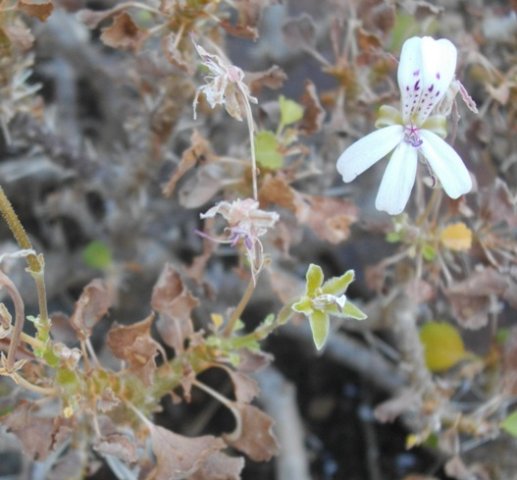Pelargonium xerophyton

Author: Ivan Lätti
Photographer: Ivan Lätti
Pelargonium xerophyton, commonly the desert geranium, is a caudiciform member of this large and varied genus. This means that it has thick, succulent and in this case a branched basal stem that retain water, a survival feature in its arid habitat. The hardy, shrubby plants become rounded to spreading as they mature, rarely reaching heights above 50 cm, usually more like 12 cm. The many upper branchlets are smooth and twiggy, the bigger stems reaching a diameter close to 2 cm and almost woody.
The aromatic blue green leaves are small, rounded, heart-shaped to obovate, growing on stalks of variable length. The leaves are usually crowded at the stem tips, the internodes short. The leaf margins are toothed, especially near the tips. The leathery to fleshy blades are sparsely hairy and unmarked. The plant is summer deciduous, the leaves drying out in summer when the plant flowers, as can be seen in the picture taken in November. The leaf length is about 1 cm.
The mostly white, rarely pink flowers grow solitary or in pairs at stem tips. They are five-petalled with small feathery pink, red or purple markings on the top two petals, ending in blotches slightly higher up. The upper petals are close together in their lower halves. The pollen and anthers on the seven fertile stamens are noticeably orange. Bloomtime peaks in midspring but lasts throughout most of the year. The olive or greenish yellow star-shape in picture near the white flower is a calyx from which the corolla has dropped off. The dry leaves are here quite long-petioled.
The species distribution is in the northwest of the Northern Cape, the Richtersveld, as well as in the southern to central parts of Namibia.
The habitat is arid scrub in rocky succulent Karoo and desert conditions, the plants well equipped for drought tolerance. They cope in granitic, quartzitic and sandstone derived soils. The habitat population is deemed of least concern early in the twenty first century.
This is an interesting succulent for drier gardens, containers and bonsai possibilities (iNaturalist; www.bihrmann.com; https://pza.sanbi.org; www2.arnes.si; http://redlist.sanbi.org).

